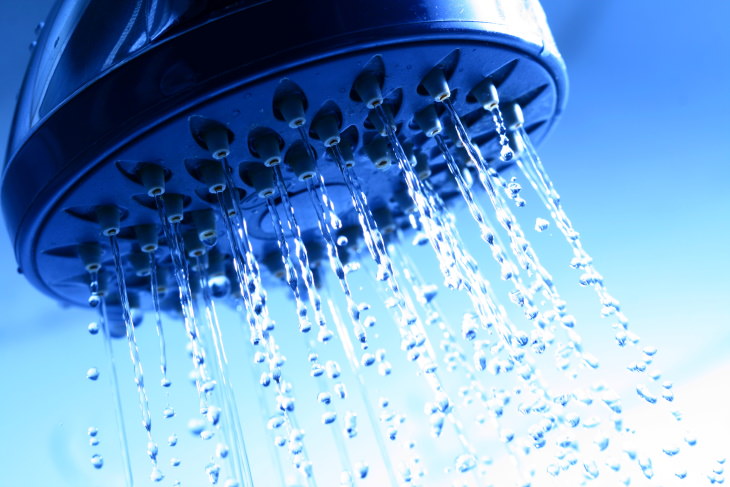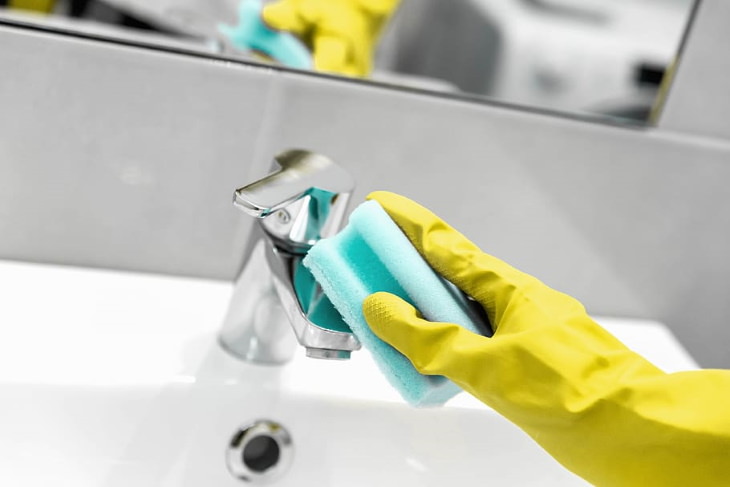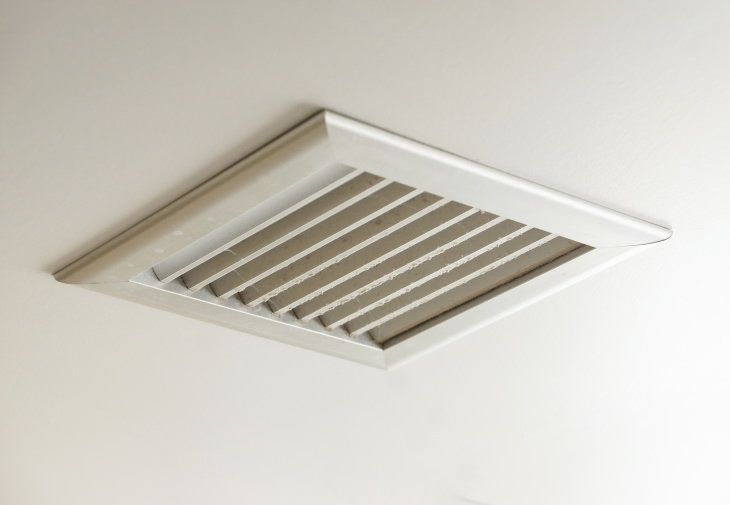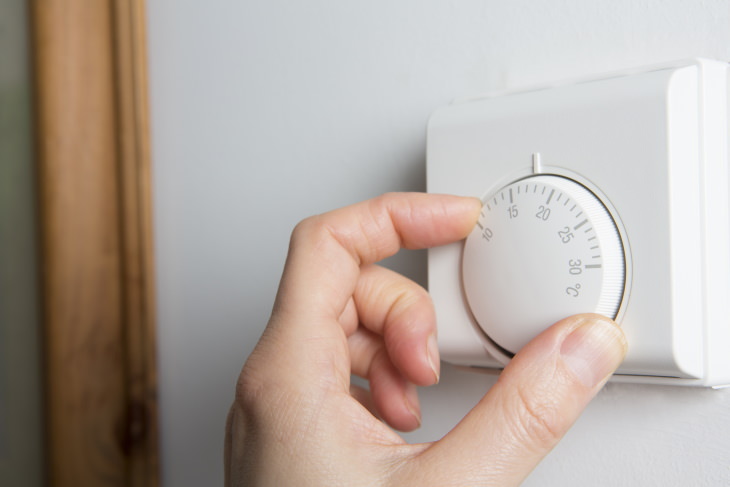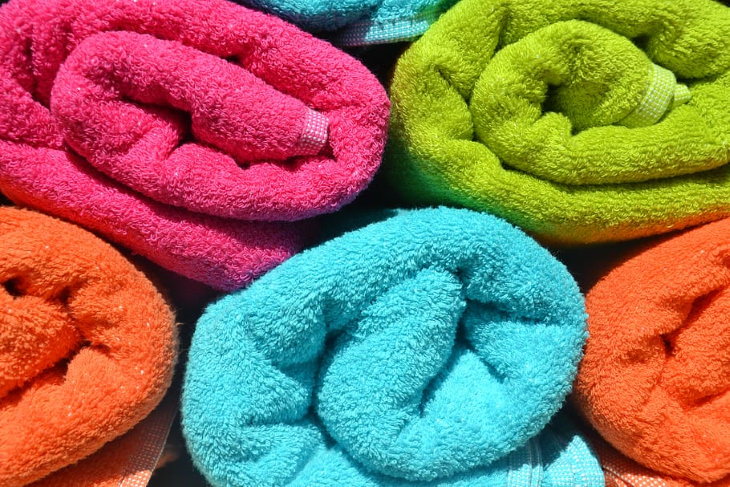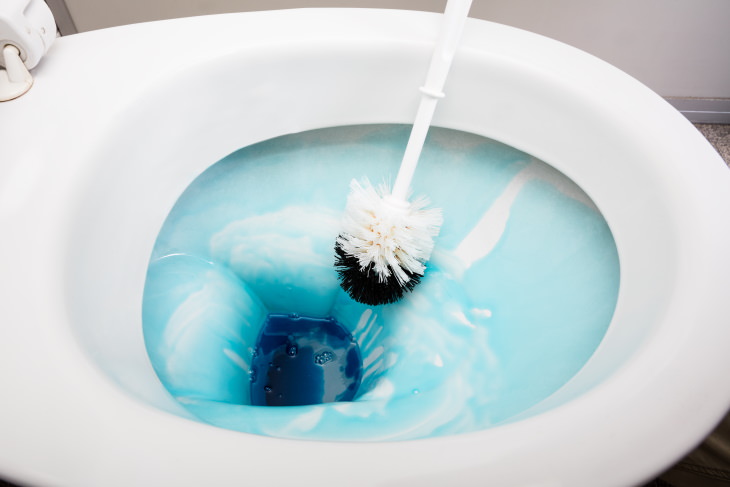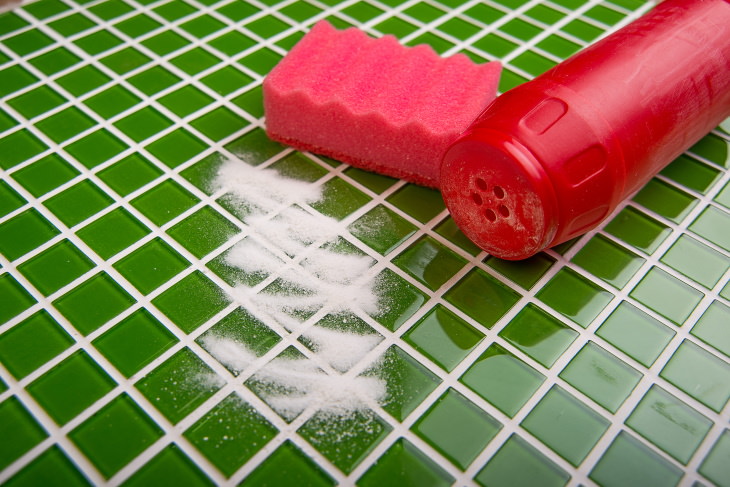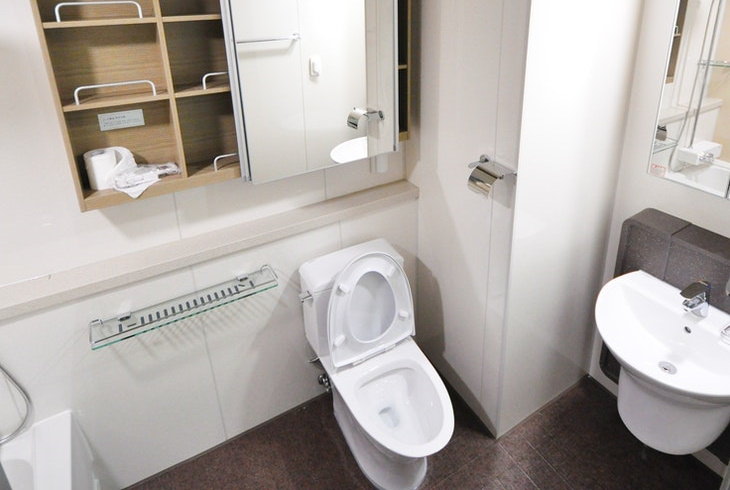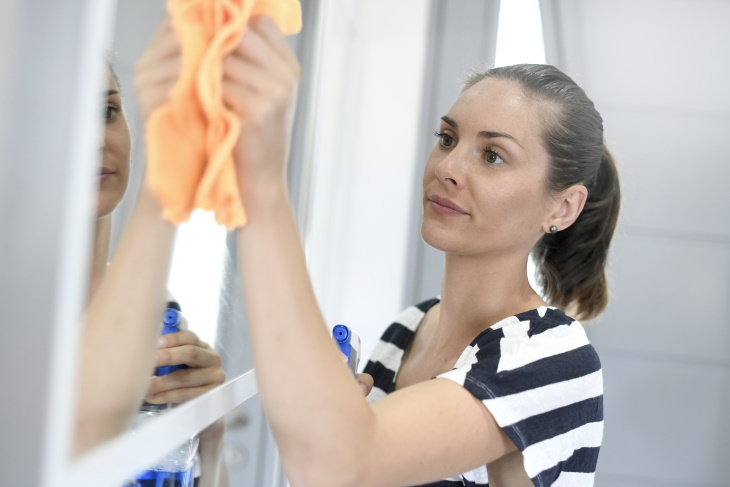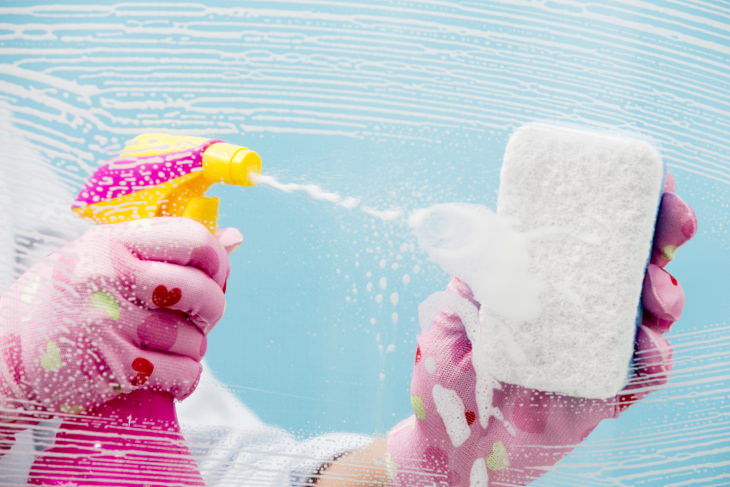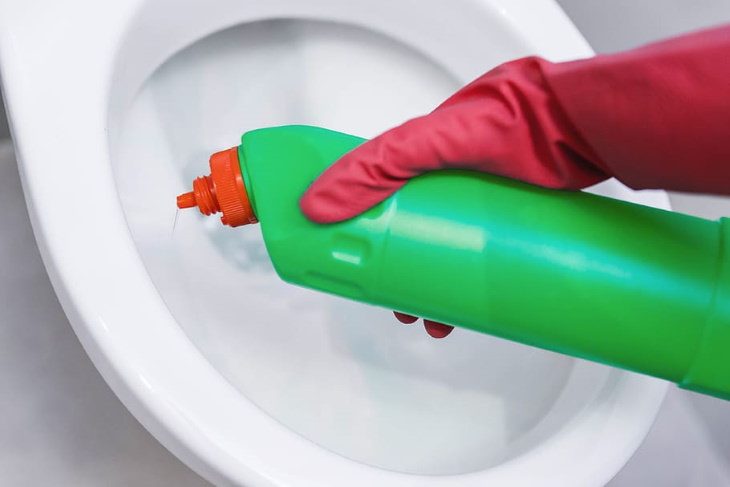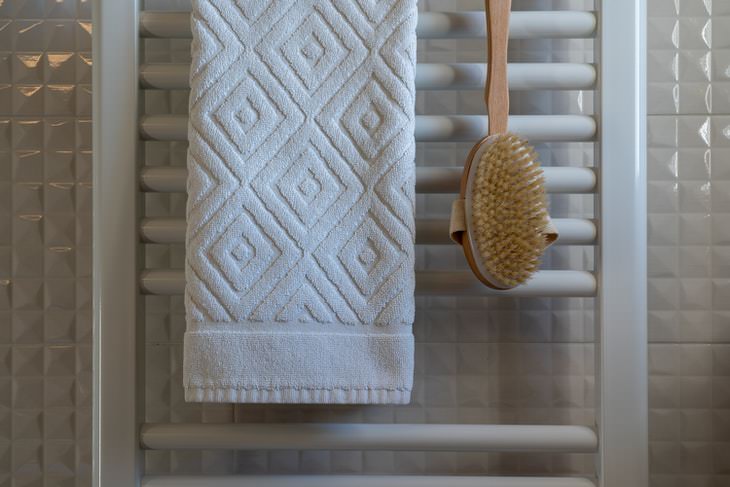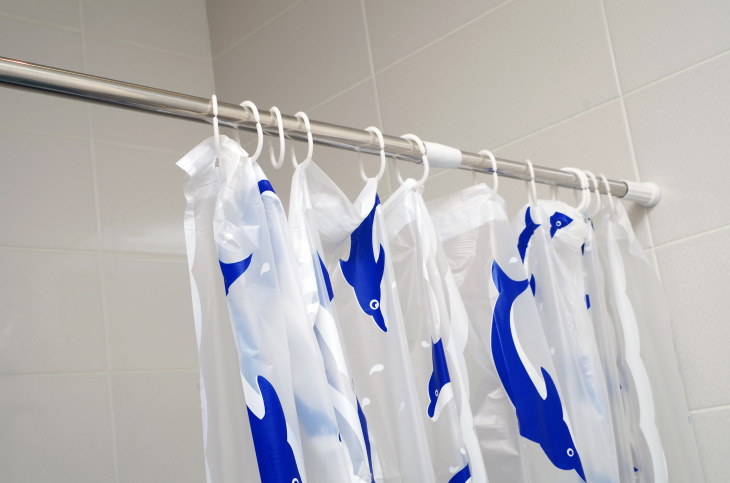1. Using a multi-purpose cleaner on every surface
The bathroom is one of those places in your home with a wide range of extremely fragile surfaces that all require their own cleaning products and techniques. We will get in more detail further in this article, but here we'd like to point out that using only one multi-purpose cleaner on all surfaces, such as mirrors, toilets, tile, and chrome will end up either degrading some of those surfaces or not disinfecting them enough.
So, if you're continuously fighting with mold or limestone in your bathroom, or you find that you have to replace faucets and tile more often than seems reasonable, the cleaning product you're using might be the underlying issue. For example, try to avoid scrubbing or using acidic chemicals on tile, ceramic, chrome faucets, and showerheads, as the acid can degrade these fragile surfaces over time, which means that you'll need to replace them sooner than you'd normally have to.
2. Forgetting to clean the showerhead
Just think about it - we use this item every day, running thousands of gallons of water through it, and yet, many people rarely clean the showerhead. As a result, it can get clogged, especially if you live in an area with hard water (water that contains a lot of minerals that tend to build up on bathroom surfaces). Most importantly, however, showerheads can harbor various strains of harmful bacteria if not cleaned regularly, with one 2018 study even finding an increase in lung infections in areas where pathogenic bacteria in showerheads were discovered, so this seemingly minor cleaning mistake can be quite harmful.
To clean a showerhead, immerse it into a plastic bag filled with vinegar, fasten the bag with some sort of string or old hair tie, and let it soak for several hours. This will kill any germs and dissolve any mineral buildup. Then, wipe the showerhead down with a cloth or sponge, and run hot water through it for a few minutes. Repeat as needed, ideally once a month.
3. Cleaning everything with the same sponge
It's not only your home items that can harbor harmful bacteria, mold, and other germs, the tools you use are also the perfect environment for germs to live and multiply. And while we're typically in the habit of washing cleaning cloths, sponges are a whole different story. The moist, porous texture of a sponge that one usually keeps in a dark cupboard is the best environment for germs to thrive, so you should replace these every 2-3 weeks and be mindful when using them.
To avoid cross-contamination of the different surfaces in your bathroom, it's safest to use different tools to clean various areas. Never use the same sponge to clean the toilet, bathroom, tile and mirrors. Instead, have a dedicated sponge or cloth for each of those areas and clean or replace them regularly.
4. Forgetting to turn on the exhaust fan
If you don't have proper ventilation in your bathroom, you're making the room more susceptible to mold and germs, since both of these thrive in dark and moist conditions. Turn on the exhaust fan while taking a shower or bath, and let it run for several minutes after you're done to make sure any moisture is pulled out of the air. If you don't have an exhaust fan in the bathroom, crack a window right after you get out of the shower or bath in the cold months, or even leave the window open all the time when the weather is warm.
On a different, but similar note, make sure to clean up any water spills after taking a shower or bath, otherwise, the water residue can stain your bathroom floor and promote mold and bacteria growth as well. These regular maintenance tips only take a few minutes every day, but they will be able to prevent long-term issues like mold and keep your bathroom a lot more pleasant and neat between weekly cleanings.
5. Cleaning in a cold room
Many people don't know this, but certain cleaning agents do require a warm environment to work more effectively. This is especially applicable to alkaline cleaners (such that contain ammonia, sodium carbonate, sodium hydroxide, etc. on the ingredient list), which are often used to dissolve grease and remove mineral buildup, and are extremely common.
To make these cleaning agents more potent, rinse the surface you're about to clean (like the bathtub or sink) with hot water before applying the cleaning solution. You can also turn up the heat in the entire bathroom just before cleaning - this is said by professionals to work just as well.
6. Using fabric softener on the towels
It's very tempting to use fabric softener when washing towels, as we all want to be wrapped in a soft towel when we hop out of the shower, but it turns out that doing so may make your towels less absorbent over time, which is the last thing you want from a towel.
If you find that using no softener makes the towels too stiff, try using a bit less detergent, or add a cup of vinegar instead of fabric softener. These tips will help keep your towels soft but absorbent at the same time.
7. Not letting the toilet brush dry after using
We're not saying that everyone is guilty of this mistake, but most people are guilty of this mistake. The toilet brush is one of those bathroom items exposed to germs the most, for obvious reasons, and so it makes sense if you just feel the urge to put it away right after using it. Unfortunately, this is a mistake that will create a petri dish full of harmful bacteria right in your bathroom, and little droplets of germs will end up spreading through your entire bathroom every time you use the brush.
To keep the toilet brush as clean as possible, all you have to do is let it dry out completely after using it. Simply lay the brush across the holder until dry. An occasional soak with a disinfectant liquid-like bleach will be beneficial for killing any germs, too.
8. Using in-tank toilet cleaners
Those toilet tablets and cartridges you put in the toilet tank that turn the toilet water blue may seem like a fast way to clean your toilet or maintain a pleasant smell, but plumbers recommend avoiding these products altogether. The main problem with these products is that they contain very harsh chemical detergents that can make the plastic and rubber components in the tank brittle and lead to breakage and leaks.
9. Applying abrasive cleaners or using a stainless steel sponge on tile and ceramic
Scrubbing cleaning agents that contain grains or sand-like particles are not beneficial for any surface in your bathroom, since they will scratch and disturb the integrity of the surface, making it more susceptible to breakage, damage, and staining. You should be especially careful when it comes to fragile surfaces like tile, ceramic, and chrome.
The same applies to scrubby metal sponges, which are too strong and harsh to be used anywhere in the bathroom. Instead of scrubbing away any stains, it's much better to soak a dedicated cleaning product on the surface for a few minutes, and then simply wash or wipe it away with a damp clean cloth or sponge, much like one would soak the dishes to make them easier to clean.
10. Forget to clean behind the toilet
Difficult-to-reach parts of the bathroom like behind the toilet or the washing machine can be a hassle to clean, but it's really important to reach all those areas to keep the air in your bathroom fresh, prevent odors, mold, and cross-contamination. Make a rule for yourself to clean these areas thoroughly if not every week, then at least every other week. You'll be genuinely surprised to find out how much dirt and hair gets stuck in those far reaches of your bathroom.
11. Not dusting before you clean
Dusting isn't just necessary in your living room and the bedrooms. All the cabinets, shelves, window frames, mirrors, and yes, even the lamps located in your bathroom are sadly not immune to dust accumulation, and by 'forgetting' to dust those, you might be undoing all the hard work you did while scrubbing and cleaning the bathroom.
Besides, bacteria and other germs can live in dust, too, so it's especially important to get rid of dust in the bathroom to avoid infections and other adverse health consequences. The same rule works for the bathroom floor, by the way, sweeping or vacuuming it before mopping is a must!
12. Using paper towels or lint cloths to clean mirrors
Both paper towels, kitchen towels, and old bathroom towels are a bad tool to clean mirror and glass surfaces. Don't get us wrong, we're all for reusing old clothes and other textiles as cleaning rags, but these fabrics will leave lint and particles of paper (when using paper towels) on the surface, which is bound to make the mirror or glass door in your bathroom untidy again. Instead, stick to lint-free options like old T-shirts or microfiber cloths to clean glass, and mirrored surfaces.
These fabrics will not only help you get the desired streak-free finish, but they will also leave no lint behind. However, make sure you wash them separately from other clothes after using them to avoid lint from sticking to them from other clothes.
13. Wiping down the cleaning solution too early
Weekly cleaning can take a while, and we're naturally prone to cut corners here and there to shorten cleaning time as much as we can. One place where cutting corners is not such a great idea is your bathroom. If you're used to wiping the window cleaner, the toilet cleaning liquid and whatnot immediately after applying it to the dirty surface, you're making a mistake, since you're not giving the product enough time to do its job.
Instead, spray the cleaning solution onto the item you're cleaning, spread it evenly across the surface of the item, and let it sit for a good few minutes. Meanwhile, you can continue working on a different area of the bathroom, or start cleaning a different room altogether, so you that you don't waste any time. After a good soak, cleaning away the stains will be much easier, and you can rest assured that the item is completely disinfected.
14. Cleaning your toilet or sink with a lemon-based cleaning agent
While lemons and lemon extracts are often naturally derived, they are all an acid nevertheless, and the acid eats away at the different materials, like plastic, rubber, and ceramic, used in bathroom items like toilets, sinks, and even the plumbing, especially when combined with necessary detergents already found in these cleaning products. So, it's safer to choose a different scent for your cleaning products that will make your bathroom smell just as fresh and breezy, but without the added harm.
15. Never degreasing the tub
Grease in the bathtub and sink? That's right, it turns out that there is quite a lot of it, as when we use soap, it works by essentially removing the natural oils in our skin (along with the harmful stuff like dirt and germs, of course), and some of those oils end up being stuck on the bathtub, the tile, and the sink.
To remove those without scrubbing, the easiest thing you can do is use a de-greasing product. It can be a specialized product for the bathroom, like those alkaline cleaners we mentioned earlier, or a de-greaser you'd use in the kitchen (check the label to make sure it's suitable for bathroom surfaces).
16. Keeping bathroom accessories for too long
Some bathroom accessories, such as bathroom towels and toothbrush holders, are fine to keep for years, as you can clean them quite easily. Others, however, need to be replaced regularly because they can harbor bacteria and become a health hazard. These products include loofahs, toothbrushes, body brushes, hairbrushes and bar soaps. For a fuller list of items and how often you ought to replace them, follow this link: 10 Personal Care Items that Need to Be Replaced Regularly
17. Forgetting to wash the shower curtain
Many people throw away their shower curtain liners once they get kind of grimy, which is, of course, an option, but why would you do that if you can save your money and just wash it? Few people are aware that the shower curtain liner is one of those things you can clean in the washing machine quite easily.
Simply take the shower curtain down, toss it in the washing machine, preferably with something like a towel or some cleaning cloths to give it some scrubbing action, and wash on a gentle cycle with some detergent. Hang dry, and you're done - your shower curtain will be as good as new!


